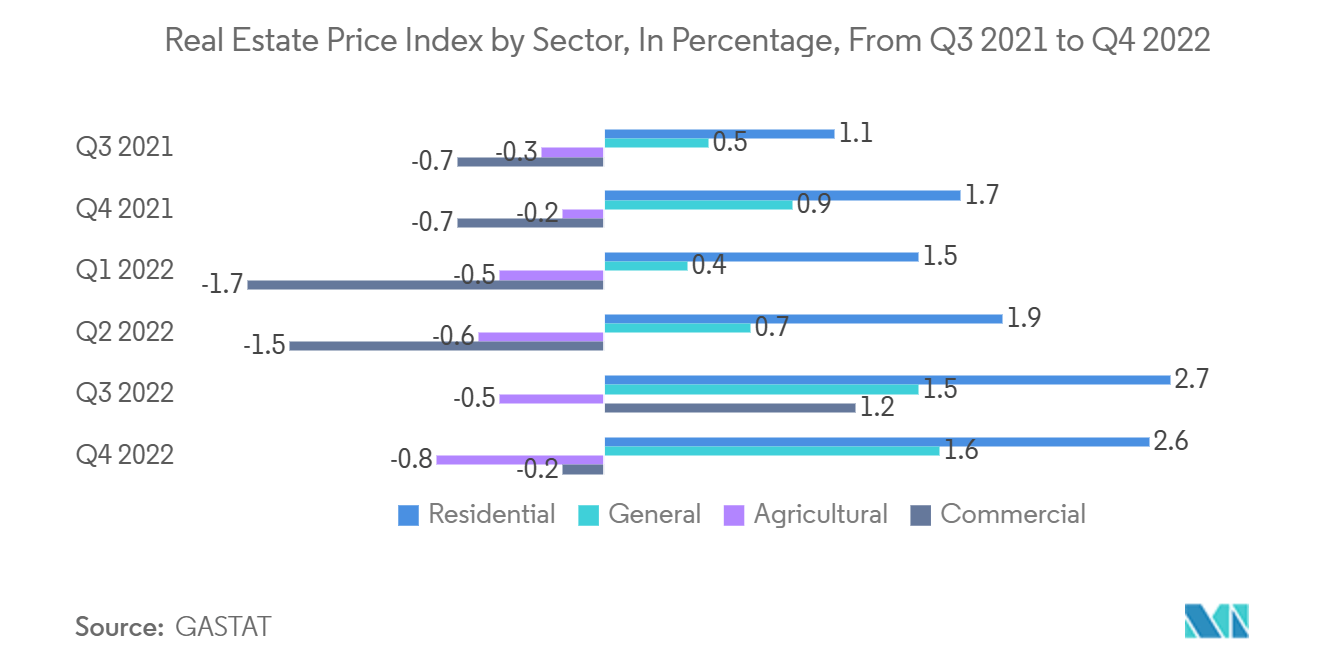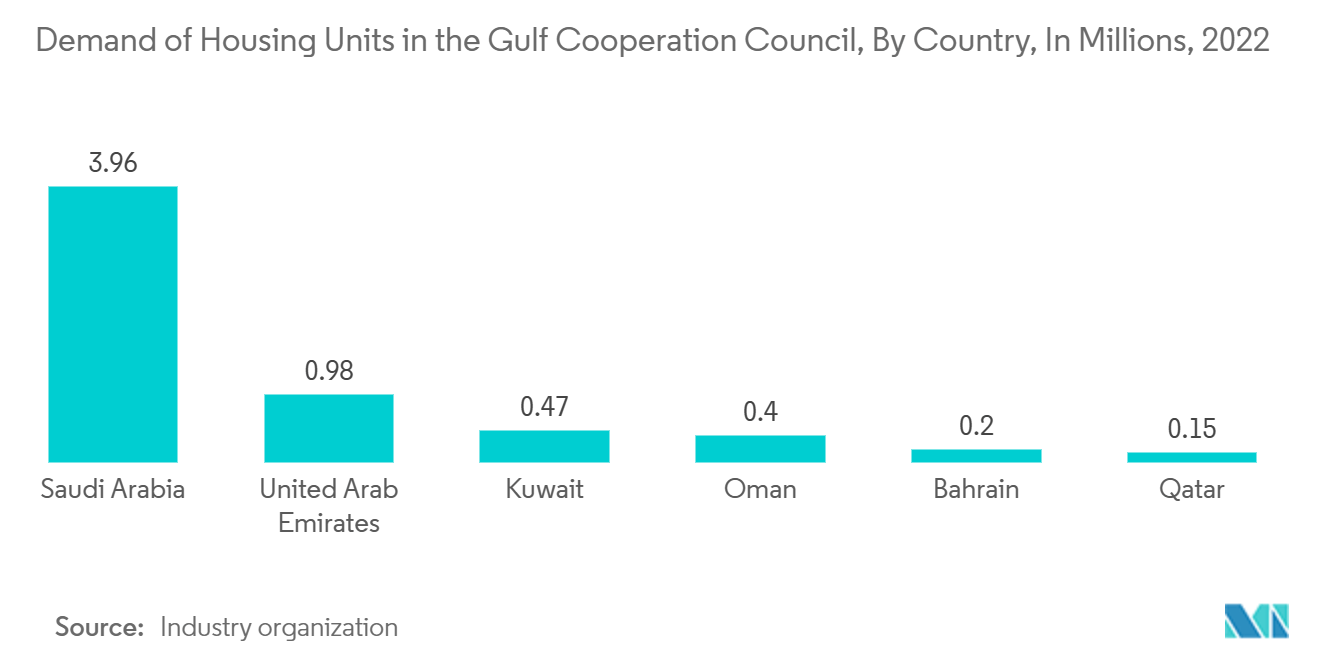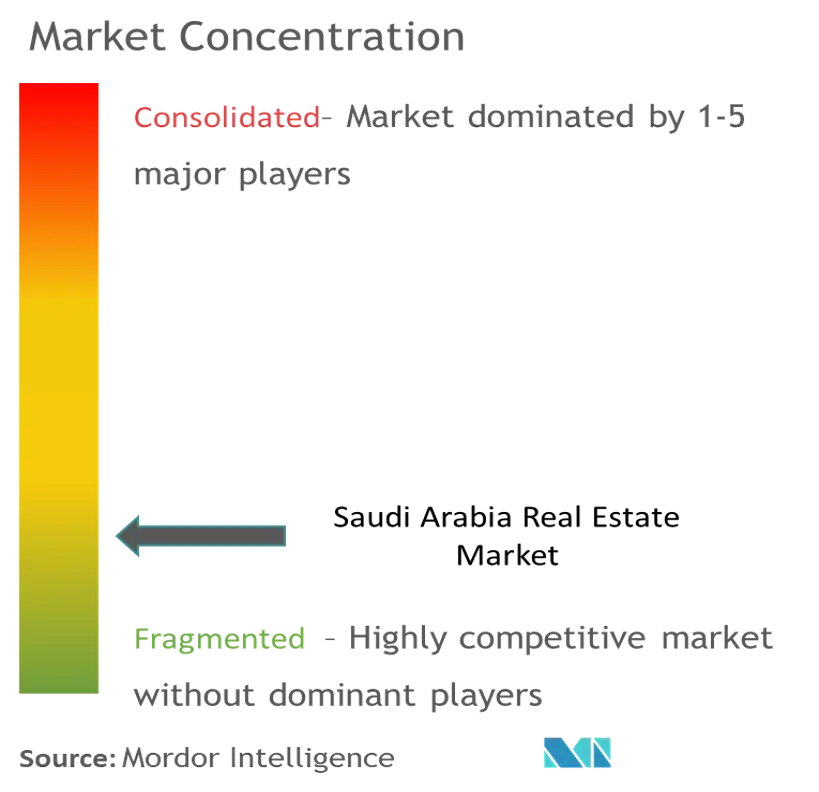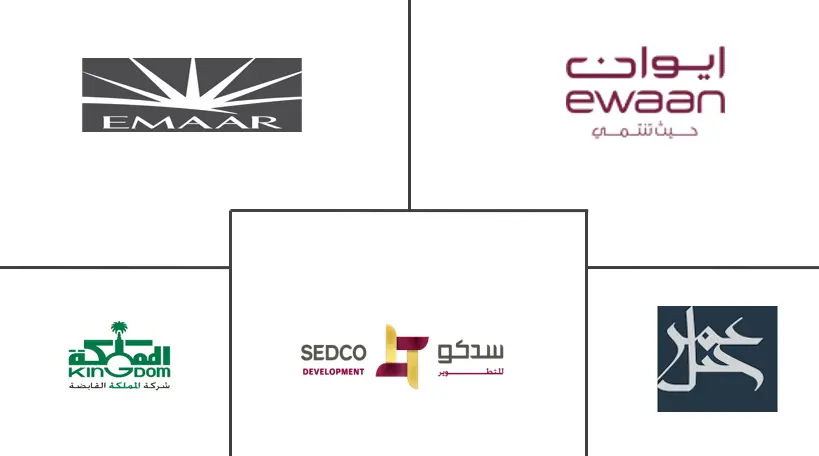
Saudi Arabia Real Estate Market Analysis by Mordor Intelligence
The Saudi Arabia Real Estate Market size is estimated at USD 67.94 billion in 2025, and is expected to reach USD 96.03 billion by 2030, at a CAGR of 7.17% during the forecast period (2025-2030).
- Saudi Arabia's office sector figures and occupier demand remained strong over the last quarter of 2022. This was particularly so in Riyadh, where stock levels remain anaemic at best and many upcoming developments are mostly fully pre-leased. Grade A offices in Riyadh saw average rental rates increase by 5.8% year-on-year increase in 2022, while Grade B rents rose by 1.5%. As for average occupancy rates, both Grades A and B stock saw occupancy levels improve slightly to 99.2% and 98.7% in 2022, marking annual increases of 0.8 and 1.9 percentage points respectively.
- In Jeddah, Grade A office rents increased by 7.4% in the 12 months to December 2022, whereas Grade B rents remained unchanged. Occupancy rates for both Grade A and Grade B offices rose to reach 90.6% and 76.0%, up from 87.8% and 74.6% in 2021. In the Eastern Province, Dammam and Khobar's office markets saw Grade A rents increase by 7.9% and 6.2% respectively over the year to 2022, with Grade B rents remaining flat. Grade A occupancy levels in Dammam and Khobar at the end of 2022 stood at 81.2% and 78.7% respectively.
- Residential transaction volumes in Saudi Arabia fell by 24.5% during 2022, compared to a year earlier. Overall, the number of residential transactions totalled 175,067 and the total value of these transactions stood at SAR 126.5 billion over this period, representing only a marginal decline of 3.7% year-on-year. On a regional level, we have seen total transaction volumes fall across the three major regions throughout 2022, where in Riyadh, Jeddah and the Dammam Metropolitan Area (DMA) total transaction volumes fell by 33.9%, 16.2% and 20.9% respectively. With regards to price performance in the residential sector, average villa prices in Riyadh, Jeddah and Dammam increased by 6.2%, 6.7% and 17.4% in 2022.
Saudi Arabia Real Estate Market Trends and Insights
The Residential Sector Sustains Country's Real Estate Market
Saudi Arabia has identified housing as one of its key projects under Vision 2030. The housing ministry aims to build 300,000 housing units over the next five years, in partnership with the private sector.
Looking at Saudi Arabia's office sector numbers, visitation to the workplace remained higher than its pre-pandemic baseline, presently standing 19.3% higher. The focus of activity remains on Riyadh, where demand continues to surpass supply. As a consequence, occupancy levels in Riyadh have increased by 0.7 percentage points in the prior quarter, reaching 98.1% on average in 2022. Constrained supply levels have also continued to sustain rental rate rise, with average Grade A and Grade B rentals increasing by 3.9% and 4.2%, respectively, in the year 2022.
To attain a housing supply of 4.96 million residences by 2030, the Kingdom will need to build around 1.2 million additional homes during the next decade. Housing demand is predicted to rise from 99,600 houses in 2021 to 153,000 houses by 2030, with an average of 124,000 dwellings built per year over that time.
In the last decade, the Kingdom of Saudi Arabia has achieved significant progress in reforming its housing industry. It is expected to accomplish its goals of 70% house ownership and an 8.8% contribution to national GDP by 2030.
In the year to August 2022, the overall number of mortgages tied to flat purchases climbed by 12% across the Kingdom, compared to a 45% fall in villas. Rising corporate activity and a rise in overall employment in Riyadh are driving up demand for residential units.
Indeed, according to the most recent Oxford Economics prediction, employment in Riyadh will have climbed by roughly 5% by the end of 2022, with a further 3% growth expected in 2023.

International Companies are Opening Regional Headquarters in Riyadh
The Saudi government has set up a new program intended to accelerate its plan to attract international companies to the Kingdom.
Saudi Arabia has announced some companies will be able to operate in the kingdom without having a headquarters in the country.
Companies with foreign operations not exceeding 1 million Saudi riyals (USD 266,000) can operate in the kingdom without local headquarters.
MISA's data also reveals that 53 investment deals were signed across various sectors during 2022. These include sectors like communications and IT, energy, and health.
Despite global economic uncertainty, the total number of new investment licenses issued during 2022 amounted to 1,163, reflecting new foreign investment license stability.
Moreover, MISA stated that, after excluding the number of new licenses issued as part of the campaign to combat commercial cover-up, 928 new licenses for foreign investment were issued in 2022.
This represents an 8.8 per cent increase year on year, reflecting the Kingdom's position as an appealing investment destination, with strong competitive advantages represented in a stable and supportive investment environment, as well as the availability of local inputs, young human resources, and the Kingdom's strategic geographical location.
Companies having foreign activities worth less than one million Saudi riyals (USD 266,000) are permitted to operate in the kingdom without establishing a local headquarters. Saudi officials expect that 480 companies will set up shop in the kingdom by 2030, as the country seeks to diversify its oil-rich economy. PepsiCo, DiDi, Unilever, Siemens, KPMG, Novartis, Baker Hughes, Halliburton, Philips, Flour, Schlumberger, SAP, PwC, Oyo, Boston Scientific, and Tim Hortons were among the corporations that had already relocated their regional headquarters.
The Kingdom of Saudi Arabia's Regional Headquarters Attraction Programme for Multinational Companies, a Vision 2030 project, is intended to provide major local benefits to the Saudi economy. The move is also intended to allow local talent to collaborate with multinational corporations. Riyadh's Grade A office average rents increased by 5.9%, while Grade B managed an increase of 3.5% in the 12 months to September 2022.

Competitive Landscape
The market is highly competitive, with increasing demand for new properties due to growth in commercial activities and increased competition.
Some of the major real estate development companies operating in Saudi Arabia are Al Saedan Real Estate, Kingdom Holding Company, Ewaan, SEDCO Development, Jabal Omar Development Company, and Emaar.
More than 95% of the local real estate developers are primitive in their work. The old ways of doing business will prove challenging to them in supplying the market with high-quality office buildings. The Kingdom mandated that all foreign companies with contracts with the government move their head offices to Saudi Arabia. This mandate implies the country's need for more office buildings to meet international standards and cover the huge demand for foreign companies and investors.
The market is expected to witness aggressive competition between local and international developers. Companies must change their strategies to survive by adopting international standards and practices.
International real estate companies are entering the Saudi market to secure their place and obtain a market share, as this is a growing and promising market in its early stage of booming.
Saudi Arabia Real Estate Industry Leaders
-
Al Saedan Real Estate
-
Kingdom Holding Company
-
Ewaan
-
SEDCO Development
-
Jabal Omar Development Company
-
Emaar
- *Disclaimer: Major Players sorted in no particular order

Recent Industry Developments
- May 2023: The National Security Services Company (SAFE), which leads the transformation of the local security services sector, has signed an acquisition agreement to acquire ABANA Enterprises Group Company's assets connected to the transit of cash and valuable goods. ABANA Enterprises Group Company is at the forefront of providing such services in the Kingdom. The acquisition of ABANA Enterprises Group Company's assets connected to the transit of cash and valuable goods will help SAFE achieve its primary goal of providing the most advanced security solutions and services for customers.
- July 2022: SEDCO Capital REIT Fund's board has approved acquiring two income-generating real estate assets worth SR700 million (USD 187 million), located in Riyadh and Jeddah. This acquisition will be covered by new units and by using banking facilities in accordance with the Fund's terms and conditions, according to a bourse filing. The Fund expects that this acquisition will positively impact its overall performance, as it seeks to add value to its portfolio, as well as its unitholders.
Saudi Arabia Real Estate Market Report Scope
Real estate is the buying and selling of land and buildings, including any permanent manmade additions, such as houses and other buildings. The Saudi real estate market is segmented By Property Type (Residential Estate (Apartments, Villas) and Commercial Real Estate (Offices, Retail, Hospitality, and Others). The report offers market size and forecasts for the Saudi real estate market in value (USD) for the above segments.
| Residential Real Estate | Apartments |
| Villas | |
| Commercial Real Estate | Offices |
| Retail | |
| Hospitality | |
| Others |
| By Property Type | Residential Real Estate | Apartments |
| Villas | ||
| Commercial Real Estate | Offices | |
| Retail | ||
| Hospitality | ||
| Others | ||
Key Questions Answered in the Report
How big is the Saudi Arabia Real Estate Market?
The Saudi Arabia Real Estate Market size is expected to reach USD 67.94 billion in 2025 and grow at a CAGR of 7.17% to reach USD 96.03 billion by 2030.
What is the current Saudi Arabia Real Estate Market size?
In 2025, the Saudi Arabia Real Estate Market size is expected to reach USD 67.94 billion.
Who are the key players in Saudi Arabia Real Estate Market?
Al Saedan Real Estate, Kingdom Holding Company, Ewaan, SEDCO Development, Jabal Omar Development Company and Emaar are the major companies operating in the Saudi Arabia Real Estate Market.
What years does this Saudi Arabia Real Estate Market cover, and what was the market size in 2024?
In 2024, the Saudi Arabia Real Estate Market size was estimated at USD 63.07 billion. The report covers the Saudi Arabia Real Estate Market historical market size for years: 2020, 2021, 2022, 2023 and 2024. The report also forecasts the Saudi Arabia Real Estate Market size for years: 2025, 2026, 2027, 2028, 2029 and 2030.
Page last updated on:
Saudi Arabia Real Estate Market Report
The Saudi Arabia real estate market is experiencing significant growth, driven by urban development, changing living patterns, e-commerce expansion, sustainability focus, remote work trends, demographic shifts, and government policies. This vibrant market, encompassing residential and commercial segments, is seeing a surge in demand for apartments, villas, offices, retail spaces, and hospitality venues. The growth is further fueled by mixed-use developments that cater to diverse community needs, combining residential, commercial, and recreational spaces. Influenced by macroeconomic factors like population growth, urbanization, and economic stability, alongside initiatives like Vision aimed at diversifying the economy and attracting foreign investment, real estate companies in Saudi Arabia are focusing on affordable housing and sustainable construction practices. This positions the Saudi Arabian real estate sector as a promising area for investment and development, with opportunities for both local and international companies. Statistics from Mordor Intelligence™ Industry Reports highlight the market share, size, revenue growth rate, and provide a forecast outlook and historical overview, available as a free report PDF download, underscoring the sector's dynamic growth and potential.



